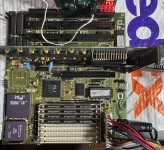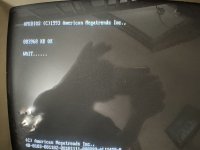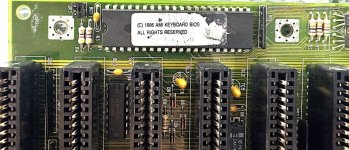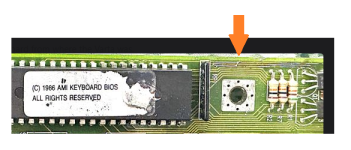Hello, I hope someone can help! I've scoured the net looking for my board but can't find the company, so It's probably one of those "unknowns."
It had Varta damage when I got it, but I got it cleaned up and replaced a few caps that were Varta damaged. On first boot I kept getting the three beep memory errors.
After inspection, I noticed tha I had some issues with a couple of pins in the sim sockets, but got those straightened out - and no more beeping.
Now when I apply power I get the video card screen, then the initial Bios screen telling me to press del to enter the bios.
Pressing del does nothing - in fact, on two different LCD monitors I get a message that says "out of range" (I think it's related to the 720x400).
I've tried a Cirrus VGA card and it does the same thing. I've tried a CRT VGA monitor and it doesn't help. Used an AT keyboard and a PS/2 with AT adapter.
Tried removing the "display" jumper" and resetting the bios as well by shorting the pins (correct?)
I've tried just about everything I can think of... The Analyzer card says "8382" and no beeping.
If it were in a crashed state would the analyzer card do anything different?
Any ideas?? Things to test?
One odd thing - one of the jumpers has a setting for 66M or 80M. Don't know what that's for. Can't imagine it's mhz??
Very much appreciate your help here!
Joe
It had Varta damage when I got it, but I got it cleaned up and replaced a few caps that were Varta damaged. On first boot I kept getting the three beep memory errors.
After inspection, I noticed tha I had some issues with a couple of pins in the sim sockets, but got those straightened out - and no more beeping.
Now when I apply power I get the video card screen, then the initial Bios screen telling me to press del to enter the bios.
Pressing del does nothing - in fact, on two different LCD monitors I get a message that says "out of range" (I think it's related to the 720x400).
I've tried a Cirrus VGA card and it does the same thing. I've tried a CRT VGA monitor and it doesn't help. Used an AT keyboard and a PS/2 with AT adapter.
Tried removing the "display" jumper" and resetting the bios as well by shorting the pins (correct?)
I've tried just about everything I can think of... The Analyzer card says "8382" and no beeping.
If it were in a crashed state would the analyzer card do anything different?
Any ideas?? Things to test?
One odd thing - one of the jumpers has a setting for 66M or 80M. Don't know what that's for. Can't imagine it's mhz??
Very much appreciate your help here!
Joe





